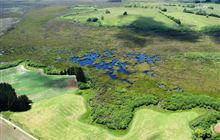Corybas orchid protection puts heat on Whangamarino
Archived content: This media release was accurate on the date of publication.
Introduction
DOC staff have carried out a special controlled burn-off to help protect a rare native plant.Date: 06 August 2020
In a scene reminiscent of a battlefield operation, staff from the Department of Conservation's Waikato District have carried out a special controlled burn-off to help protect a rare native plant.
Corybas carsei, known as the swamp helmet orchid, is a critically endangered plant found only at Whangamarino Wetland, an internationally recognised Ramsar wetland site in the Waikato.
The swamp helmet orchid has a single heart-shaped leaf no bigger than a fingernail and is between 10-30mm tall when flowering. Its known population consists of 501 individual specimens.
Whangamarino Ranger Lizzie Sharp says the attractive but diminutive swamp helmet orchid's main threats are habitat loss and theft by humans – so the specimens' exact location within the wetland is kept under wraps.
The controlled burning of vegetation around the swamp helmet orchids is carried out annually in winter, just as the plants emerge from their dormant period when they're completely underground
"We conduct controlled burn-offs of other plant species competing with the little swamp helmet orchid for sunlight," she says.
"By burning off vegetation around the swamp orchids, we increase their chances of survival and it boosts the likelihood of the plants flowering we believe by reducing the competition for light and soil nutrients with other plants."
Importantly, underlying peat is not burned – just the grasses and plants which can crowd out the orchids and deny them sunlight.
Steel frame boxes measuring 2m by 1m are taken on site and staff use them to control and contain the burn-off to the targeted area. Gas torches are used for the actual burning, undertaken by staff working in pairs who are monitored by an observer to ensure safety protocols are followed.
"This is one of our most unusual jobs, and it's a reflection of the intense level of management and commitment to protecting this species," Lizzie Sharp says.
The orchids are monitored three times a year during their key growth stages – leaf growth, bud growth and flowering.
The emergence of the single leaf represents an individual orchid, and a sign of success is when the specimen produces a bud which in turn becomes a flower.
Of 393 specimens monitored this season, 102 had a bud growth, which is an encouraging sign for the rangers who manage the species.
In addition, a further 107 specimens were found outside the usual monitoring area – a great boost to the known abundance of the population.
Contact
For media enquiries contact:
Email: media@doc.govt.nz

